Wider World
Feature
Nurturing Mumbai Dreams
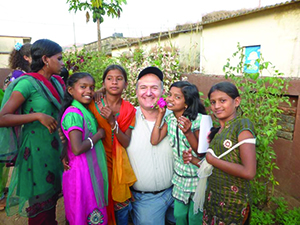
The slums of Mumbai would probably not rank very high on a list of places that strengthen Jewish identity and encourage Jewish peoplehood. But it is here, against fields of dirt pocked with litter, rags, rocks and excrement as far as the eye can see, that young Jewish volunteers from around the world work together with their Indian Jewish peers toward a quintessentially Jewish goal: feeding the hungry—literally, emotionally and educationally.
In one of several one-room schoolhouses in Kalwa, a small town on Mumbai’s outskirts, 20 children ranging in age from 4 to 12 sit cross-legged on a cement floor covered with a colorful thin rug. The only light comes from the open door and a hole in the corrugated tin roof. An English alphabet chart hangs on the wall near a clock, a gift from volunteers. The children are gleeful and eager, oblivious to the stark poverty around them. Some are dressed in school uniforms, natty in their white shirts and ties, their plastic satchels festooned with cartoon characters.
“What is your dream? What do you want to become?” asks Cochin-born Leya Elias, 23, a program coordinator for Gabriel Project Mumbai (GPM), a four-year-old Jewish initiative that is the brainchild of Jacob Sztokman, 45, an Australian-born Israeli. The children clamor to give theiranswers. “I want to be a teacher, to teach another child,” one says, standing up proudly. “I want to be a soldier, to protect the country and catch the robbers,” answers another.
GPM is supported by a variety of Indian and Jewish social justice and women empowerment organizations. In 2011, while Sztokman was working for an Internet security company, he visited the slums and was appalled to learn that they are home to seven million children. In Kalwa alone, 120,000 people (40,000 of them children), originally from rural areas, are crammed into two or three square miles with limited access to food, water, electricity, sanitation, education and health care. Children as young as 4 work as ragpickers and sewage cleaners, earning a few rupees to help their families survive.
Sztokman abandoned his high-tech career to create GPM. Its mission is simple: Eat to learn. “Education is the only way to break the cycle of poverty—and food is the incentive for the parents,” he says.
Nutritious daily meals delivered to 1,000 children (500 in Kalwa, the rest throughout Mumbai) in 25 classrooms run by Reach Education Action Programme (REAP), a local NGO and one of GPM’s partners, encourage parents to send their children to school; attendance has increased by 50 percent since GPM began collaborating with REAP.
About 150 women in the slums are paid to prepare and cook meals; running the enterprise as a co-op empowers them and increases their financial independence. Twice a week, GPM volunteers work side-by-side with them in the home of one of the women. They wash rice, make chapatis and separate hundreds of bananas into baskets for distribution with the hot meals. The women stir vats of sweet jaggery, spice vegetable curries with chili, turmeric and cumin and chat noisily.
The women don’t know much about GPM—just that the project’s volunteers are doing good things by teaching the kids. The co-op was established at the women’s initiative and operates with microcredit funding. (In July, GPM opened a medical clinic. In September, GPM founded Love2Learn, schools that will serve 500 children in 20 rural villages in Western Maharashtra.)
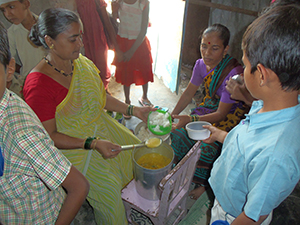
Sztokman added one more piece to the program: GPM would also revolve around the vision and energy of young adults, who would simultaneously learn first-hand about global responsibility and tikkun olam. He hired members of the Mumbai Jewish community to staff the organization; created an international volunteer track in collaboration with Entwine, the young adult program of the American Jewish Joint Distribution Committee, another partner; and later introduced an internship program for Indian Jewish students and young professionals.
“In the slums, children are given the message that they cannot have dreams,” says Sztokman. “Children in extreme poverty stay in extreme poverty. The volunteers give the message that the children are worthy and they should have the opportunity to dream.”
The children, who are Hindu and Muslim, don’t know that their GPM teachers are Jewish. “We are not out there to promote Judaism,” says Sigalith Kurulkar, 29, a program coordinator. “We are here to help the children. What’s important is the action. Judaism talks a lot about tikkun olam, but do we do it?”
More and more, Jews are doing it. GPM is one of several global projects run by Jewish entrepreneurs trying to bring social change to communities beyond their own. A study by Olam, a new initiative promoting global Jewish service, identifies over 40 Jewish organizations that address challenges like disease, poverty and hunger. “Jews have a duty to help all human beings who are vulnerable,” explains Sztokman, who named the project after his grandfather as well as Gavriel Holtzberg, the Chabad rabbi who was killed in the 2008 terrorist attack on Mumbai.
About 30 volunteers come to GPM each year—they have hailed from the United States, Canada, Australia, England, Italy, Israel and the Czech Republic and spend two months learning about global poverty, international development, Indian culture, Hindi and Marathi (the local languages), Indian Jewish history and the Jewish ethics of social justice.
Bombarded by children asking for high-fives and handshakes each morning, the volunteers enrich the basic REAP curriculum of reading, writing, math and English, with informal lessons on art, music, science, geography and more. They sing, play games, conduct simple experiments and communicate through the help of GPM’s translators and teachers.
Sztokman travels to Mumbai from his home in Modi’in every six weeks. “The program allows the volunteers to confront their identities,” says Sztokman. “It makes them ask why they are doing this service—why as human beings and why as Jews?”
“My Jewish identity was already strong but I left with a feeling of consistency and fulfillment,” says Melissa Rutman, 26, a New York resident, Jewish day school graduate and law school graduate who volunteered in 2013. Rutman describes herself as the granddaughter of survivors, raised in a Conservative home with the values of hesed and tzedaka. She searched out a direct-service program while working in a corporate law firm, where she felt “somewhat disconnected” from social justice projects.
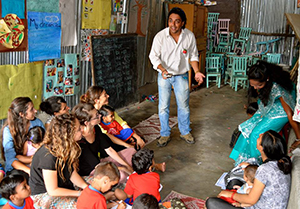
Awareness, says Rutman, is a huge part of what she took home. “I learned how to treat someone living in poverty with dignity and respect,” she says. “GPM challenged my biases. I noticed myself carrying my coat and purse close to me during my first days in the slums. But these are not necessarily people who would be committing crimes. [Back home] in New York, I’m now attuned to prejudices I might have or judgments I might make that are not founded in reality. I came away with a sense of gratitude for how I was raised—especially my education and my parents’ dreams and hopes for me.”
Mumbai-born Kurulkar shares Rutman’s perspective. “We learn so much from the kids,” she says. “I was born into a good family with good ethics. I didn’t think twice about the food on our table. Now I’ve witnessed things that have changed my entire outlook.” Kurulkar has a bachelor’s degree in biotechnology from Mumbai University and ran Jewish youth activities for the JDC.
David Ramrajkar is a translator and teacher as well as the volunteer liaison and one of two security officers. A graduate of the local Jewish high school and a former sales executive, Ramrajkar, 34, also volunteers with the Indian Jewish Security, which guards Jewish organizations around Mumbai. The children call him Salman Khan (a well-known Bollywood actor he resembles) and hold fast to his legs to prevent him from leaving at the end of class. “Whenever I enter the classroom I forget the world,” he says.
“My experience has reinforced the notion that relationships have the ability to transcend verbal communication,” writes Elana Winchester, a 2014 volunteer, on the GPM website. “The kids freak out over Duck Duck Goose, PowerPoint presentations, coloring, music and Limbo—such simple things that we take for granted.”
“The children develop a huge emotional connection with the volunteers that helps motivate them to want to learn, grow and engage with the world,” says Elias, who has a master’s degree in public relations and corporate communications. It also has a huge impact on the volunteers. GPM inspired Winchester, 24, to change her career focus to nonprofit work; she is currently communications and marketing coordinator at Areyvut, a New Jersey nonprofit that connects Jewish youth and teens to tzedaka and tikkun olam activities.
Despite the children’s happy demeanors, harsh realities intrude. Winchester didn’t know why one student stopped coming to class until she bumped into him carrying two jugs of water. He had stopped attending because it was his responsibility to make sure his house had water. Girls have it worse. Some are married off early; some work as indentured servants or prostitutes to survive. Lack of education engenders high fertility and infant mortality rates.
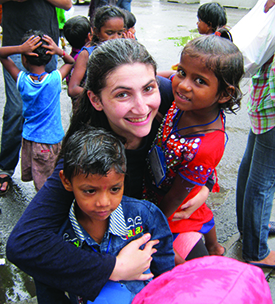
Winchester says her prior knowledge of India was limited to what she saw in the film Slumdog Millionaire—but the children’s knowledge of their own country is not much deeper: They don’t even know the word India. To change that, the Indian volunteers organize bimonthly trips to museums, parks and art galleries. On a trip to the Jewish community center, a two-story building, the children were told to go up to the second floor. “They looked at the teachers and volunteers and said, ‘What do we do now?’” Sztokman recalls. “They had never gone up stairs to a second floor before.”
The memory of that day has stayed with Rutman. “This was the first time they had even seen their own city,” she says. “They wore their Diwali [a Hindu holiday] and Eid [Muslim holiday] outfits with sequins and petticoats and the boys had their shirts tucked in. We took them to look out over the ocean and asked them where they would want to go if they could go anywhere in the world. They were intrigued by the minutiae of technology like toilets and faucets with running water. It was exciting to help open their eyes to their own backyard.”
Interfaith relationships flow naturally from GPM’s work. REAP, its nondenominational partner, was founded by Father Trevor Miranda, a Jesuit priest. “There is no word for anti-Semitism in any of the 37 languages in India,” Sztokman says, pointing out that India’s population is about 80-percent Hindu, 18-percent Muslim and 2-percent Christian. “It’s a religiously pluralistic society and everyone is accepted.” The caste system, though officially outlawed, still has a pervasive impact. People from lower castes live in the urban slums, and there are quotas for members of disadvantaged groups in government positions and universities.
Along with a strong commitment to their community, GPM staff struggle with plans for the future. “Indian Jews are dwindling day by day,” says Elias. “I feel very sad about it but, at the same time, I am working for [the Jewish future] through GPM. I can’t do anything for the [Cochin] community—there are only 29 Jews and little Jewish life…. But in Mumbai there is still a community of 4,500 and the youth can make a big difference.” Her father, a leader in Cochin, is advocating for her to make aliya, where her sister is a student at the Technion in Haifa. “I have to see; I’m not sure,” Elias says.
Today, most Indian Jews have relocated to Israel. “That’s our place, our country,” says Kurulkar. “On a practical level, it will be a better life.” But then, she thinks about the rich history of her Bene Israel community. As part of their education about Indian Jewish history, volunteers take a trip to the Konkan coast, where, according to tradition, seven couples on a boat escaping Hellenist persecution in Israel survived a shipwreck over 2,000 years ago. They visit an ancient cemetery where the survivors are said to be buried.
“At the cemetery I felt something special,” Kurulkar says. “I looked at each tombstone. I was moved and thinking, ‘These are my people. This is where I come from and where I belong.’ It made me reconsider aliya because my people have struggled for years to remain Jewish. Suddenly I wanted to learn the history of Jews in India and in the world. I feel a responsibility for keeping the Jewishness of the community alive.”
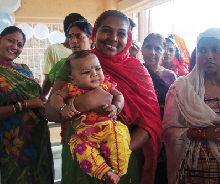 Making Health Care Available
Making Health Care Available
Shravan Sharma was only 11 when he died in June 2014. No one is sure of the cause, but the fever that preceded his sudden death might have been diagnosed and treated had there been accessible health care nearby. A clinic named and opened in his memory in August hopes to prevent similar tragedies.
The Shravan Health Center in Kalwa, the latest initiative spearheaded by Gabriel Project Mumbai in partnership with Doctors for You and Sundara Soap, provides comprehensive health services in Indian slums. “Shravan’s death was a wake-up call about how many preventable deaths there are among children in the slums,” says Jacob Sztokman, GPM’s founding director. “This triad of health, nutrition and literacy is the formula necessary for real transformation and giving these beautiful children a real chance at life.”
The clinic is providing sick visits, minor acute care, treatment for burns and injuries, immunizations, health and nutrition education, prescription assistance, preventive checkups, referrals to specialists, workshops on disease prevention and healthy living and more. A special fund will subsidize advanced treatments outside the two-room center. Staff doctors and nurses will serve an estimated 45 patients a day—about 200 patients a week, or almost 10,000 women and children a year. A community outreach team of local women led by a social worker is being trained as health representatives who will go house to house giving vaccinations and providing basic health-care education.
Rahel Musleah (rahelsjewishindia.com) leads trips to Jewish India.








 Facebook
Facebook Instagram
Instagram Twitter
Twitter
Leave a Reply